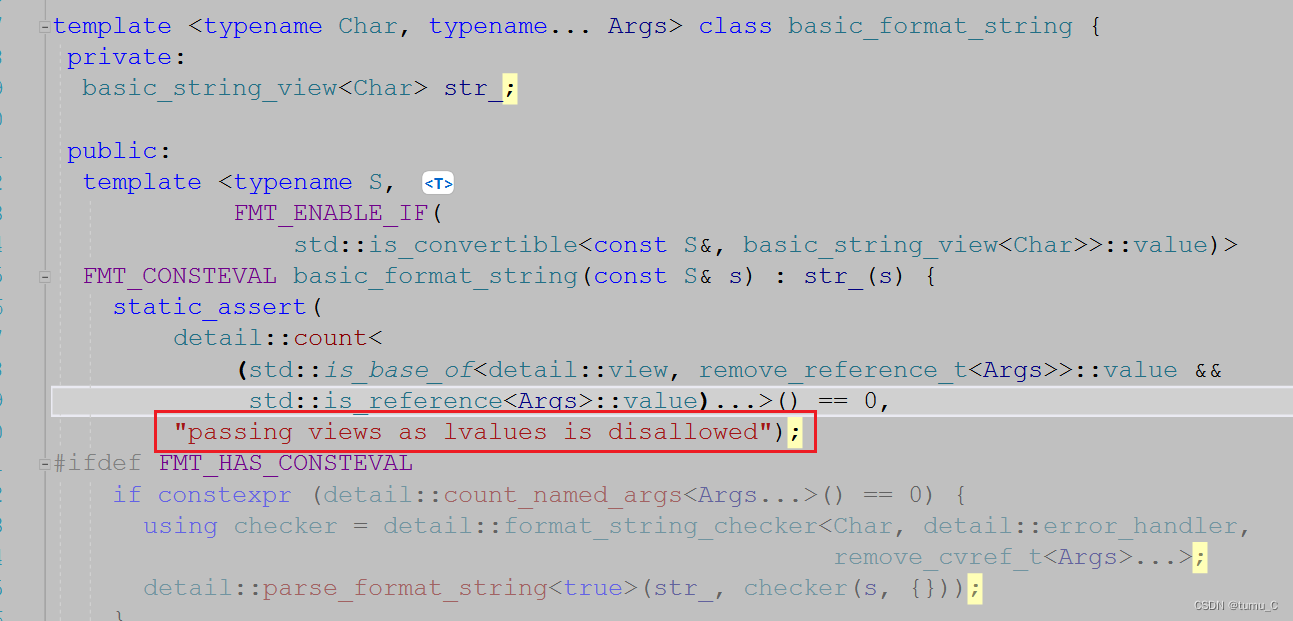注意:fmt::format内部调用的就是fmt::format_to
demo:
#include <fmt/core.h>
#include <fmt/args.h>
void fun()
{
double const d = 123.45678;
int x = 10;
fmt::memory_buffer buf;
fmt::format_to(std::back_inserter(buf), "{:e},{}", d, x);
auto info = to_string(buf); // "1.234568e+02,10"
}fmt::format_to的定义:
template <typename OutputIt, typename... T,
FMT_ENABLE_IF(detail::is_output_iterator<OutputIt, char>::value)>
FMT_INLINE auto format_to(OutputIt out, format_string<T...> fmt, T&&... args)
-> OutputIt {
return vformat_to(out, fmt, fmt::make_format_args(args...));
}
//format_string的定义
//char是字符类型,这里传进来的Args...是double const&
template <typename... Args>
using format_string = basic_format_string<char, type_identity_t<Args>...>;
仔细观察format_to这个函数,基本上只有两个参数类型,一个是OutputIt,一个是...T
在demo里用的时候,没有显式给出变量类型,而是纯由编译器来推导
fmt::format_to(std::back_inserter(buf), "{:e},{}", d, x);很神奇,怎么推导出来的呢。
第一个肯定就推导成OutputIt了。
第二个参数fmt的时候,fmt按照format_string<T...>的样式进行推导,此时要确定T...,那么这个T...就是下面的两个参数const double和int了,由于这里用的是模板,而且用的是T&&,所以折叠后就变成了const double&和int&了
第三个和第四个参数,就属于T...了
看basic_format_string的定义。
template <typename... Args>
using format_string = basic_format_string<char, type_identity_t<Args>...>;format_string的定义中,第一个参数是字符类型char,剩下的是type_identity_t<Args>...
一定要注意它的这个写法,看type_identity的定义,这个原函数的值type就是传给它的T:
template <typename T> struct type_identity { using type = T; };
template <typename T> using type_identity_t = typename type_identity<T>::type;type_identity_t<Args>...最后的...表示要把变长参数进行展开,也就是:
type_identity_t<Args_0>, type_identity_t<Args_1>, type_identity_t<Args_2>, ...也就是:
type_identity<const double&>::type, type_identity<int&>::type所以basic_format_string实例化后的结果就是:
basic_format_string<char,double const &,int &>
template <typename... Args>
using format_string = basic_format_string<char, type_identity_t<Args>...>;
推导的结果:

拷贝出来,如下:
fmt::v8::format_to<std::back_insert_iterator<fmt::v8::basic_memory_buffer<char,500,std::allocator<char> > >,double const &,int &,0>
(
std::back_insert_iterator<fmt::v8::basic_memory_buffer<char,500,std::allocator<char> > > out={...},
fmt::v8::basic_format_string<char,double const &,int &> fmt,
const double & <args_0>,
int & <args_1>
)
basic_format_string在初始化的时候,

注意下面也牵扯到展开,而且这种更不容易看懂:
detail::count<
(std::is_base_of<detail::view, remove_reference_t<Args>>::value &&
std::is_reference<Args>::value)...>() == 0void fun()
{
double const d = 123.45678;
int x = 10;
fmt::memory_buffer buf;
//fmt::format_to(std::back_inserter(buf), "{:e},{}", d, x);
auto arg0 = fmt::arg("x", 1);
fmt::format_to(std::back_inserter(buf), "{:e},{x}", d, arg0);
auto info = to_string(buf); // "1.234568e+02,10"
}

这里的count函数,是记录view的子类引用的个数的,如果不为0,那么就编译报错。
template <bool B = false> constexpr auto count() -> size_t { return B ? 1 : 0; }
template <bool B1, bool B2, bool... Tail> constexpr auto count() -> size_t {
return (B1 ? 1 : 0) + count<B2, Tail...>();
}





















 2574
2574











 被折叠的 条评论
为什么被折叠?
被折叠的 条评论
为什么被折叠?








